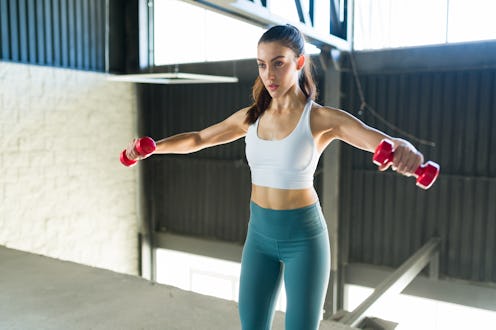
While adduction and abduction exercises can easily sound like the same thing, they’re actually opposite motions that have totally different effects on the body. One involves movements that pull inwards and the other involves pushing away. But which is which?
To put it simply, adduction means to “pull into the body” while abduction means to “draw away from the body,” says Wendy Erven, a certified personal trainer, Pilates instructor, and founder of Core10 Pilates.
An adduction exercise is any movement where your limbs come back in, like when you squeeze an exercise ball between your thighs. It’s also possible to adduct your arms as well as your shoulder blades, she says, by doing exercises that pull them down and in.
Abduction is the exact opposite of that, says Dr. Scott A. Weiss, DPT, a doctor of physical therapy and founder of Bodhizone Human Performance. “This is the action of the leg or arm leaving the midline,” he tells Bustle. Weiss points to single-leg raises and lateral arm raises as examples of abduction. Read on for more on the differences between abduction and adduction exercises and how each can benefit your workout routine.
The Benefits Of Adduction Exercises
Adduction exercises work the muscles that are, well, called the “adductors,” Weiss says. This is a group of five muscles in the lower body located near the thighs: the adductor longus, adductor brevis, adductor magnus, gracilis, and pectineus. There are also four main adductor muscles in the upper body that help bring the arms back in: the pectoralis major, lattissimus dorsi, teres major, and teres minor, Weiss explains. (Think your lats, pecs, etc.)
The adductor muscles are strongly connected to the core, Erven says, so if you have a weak core you likely also have weak adductors. On the plus side, “you can strengthen them both by adding adduction exercises into your routine for more stability from the inside out,” says Weiss.
There are plenty of adduction moves to choose from, notes Janelle Fleites, PT, DPT, a doctor of physical therapy and owner of Impact Physical Therapy and Sports Performance. Try exercises like the side-lying hip adduction, gluteal bridges where you squeeze an exercise ball between your thighs, and Copenhagen side planks to work your hip adductors, she says. For the upper body, Erven points to pull-ups, which adduct or draw in your upper arms and shoulder blades.
Adduction exercises play a role in your body’s overall strength and balancing skills. In the lower body they help stabilize your hips and pelvis, Fleites says, while in the upper body they help you maintain good posture and shoulder stability. “It is especially beneficial to have strong adductors for a stronger squat, and for all cutting and change-of-direction activities,” she adds.
The Benefits Of Abduction Exercises
You’ve also got abductor muscles. In the lower body, the abductors include the gluteus maximus and minimus as well as the tensor fasciae latae, Weiss says. And in the upper body, the abduction muscles are the supraspinatus, deltoids, and upper traps.
Working these muscles with abduction exercises will help ensure you have good muscle balance and mobility. For example, strong hip abductor muscles can mean better posture in the lower spine, Erven says, while strong shoulder abductors help you maintain stability in the shoulder joints — all good things when it comes to standing up straight.
Abductor exercises can help you feel more powerful in general. Having the ability to push away from the body, or to press yourself up from a squat or as you get off the floor, makes it easier to move through everyday life, Evren says. As an added perk, strong abductors can also decrease your back pain. “When the hip abductors are weak, the pelvis is not stable, and the lower back is usually the first thing to show symptoms,” she adds. “People with back pain often can decrease pain simply by strengthening abductors like the glute medius, a muscle that helps the leg to push away from the body.”
Fleites recommends trying moves like standing hip abductions with a resistance band, lateral or side walks with a resistance band around your ankles, or side-lying hip abductions. To work the upper body, Erven recommends lateral arm raises with dumbbells.
Adduction Vs. Abduction
According to Erven, adduction and abduction are equally important when it comes to your posture, joint stability, and decreased joint pain. “Creating joint stability from the inside out — via adduction — and the outside in — through abduction — is also essential for less back pain, more fluid mobility, and better balance,” she explains.
To remember which is which when you’re exercising, Weiss suggests thinking of it like this: The limb leaving the body is abduction, while the limb coming home is adduction.
Studies referenced:
Domínguez-Navarro, F. (2022). Impact of hip abductor and adductor strength on dynamic balance and ankle biomechanics in young elite female basketball players. Sci Rep. doi: 10.1038/s41598-022-07454-3.
Kak, HB. (2016). The effect of hip abductor exercise on muscle strength and trunk stability after an injury of the lower extremities. J Phys Ther Sci. doi: 10.1589/jpts.28.932.
Kim, M-H. (2014). Optimal and Maximal Loads during Hip Adduction Exercise by Asymptomatic People. J Phys Ther Sci. 2014 May; 26(5): 777–778. doi: 10.1589/jpts.26.777
Lam, JH. (2021). Anatomy, Shoulder and Upper Limb, Arm Abductor Muscles. In: StatPearls [Internet]. https://www.ncbi.nlm.nih.gov/books/NBK537148/.
Lee, SP. (2012). The influence of hip abductor muscle performance on dynamic postural stability in females with patellofemoral pain. Gait Posture. doi: 10.1016/j.gaitpost.2012.03.024.
Peterson, S. (2019). Physical Therapy Management of Patients With Chronic Low Back Pain and Hip Abductor Weakness. J Geriatr Phys Ther. https://pubmed.ncbi.nlm.nih.gov/28914719/
Trammell, AP. (2021). Anatomy, Bony Pelvis and Lower Limb, Tensor Fasciae Latae Muscle. In: StatPearls [Internet]. https://www.ncbi.nlm.nih.gov/books/NBK499870/.
Sources:
Wendy Erven, certified personal trainer, Pilates instructor, founder of Core10 Pilates
Dr. Scott A. Weiss, DPT, doctor of physical therapy, CEO, founder of Bodhizone Human Performance
Janelle Fleites, PT, DPT, doctor of physical therapy, owner of Impact Physical Therapy and Sports Performance